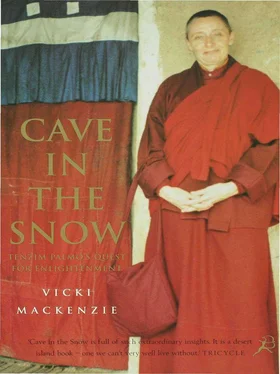Arguably, the most radical of all her deprivations was the absence of a bed. It was not that the cave was too small, it was simply that Tenzin Palmo did not want one. She intended to follow in the tradition of all serious meditators and train herself to do without sleep. According to the sages, sleep was nothing but a tragic waste of precious time. If we spent eight hours of every day asleep, that amounted to a third of our life which, they calculated, if we lived until we were seventy added up to some twenty-four years of voluntary unconsciousness. Time which could be spent striving for spiritual betterment in order to help all living beings. Knowing this the yogis disciplined themselves not to fall asleep but to use the refined levels of consciousness induced by meditation to bring about both mental and physical refreshment. It was agreed that the quietness and solitude of a cave was the perfect place to practise such a feat, for even the best of them would have been hard-put enduring sleeplessness while living in the midst of a busy town. But sitting up all night in their remote hideaways they learnt to see that whatever images arose from the subconscious, be they in the waking, semi-waking, or sleeping state (should they nod off), were nothing but projections, ‘mere appearances’ from their own minds. It was, they said, an invaluable exercise.
In actuality this meant that for as long as Tenzin Palmo was in the cave she never fully lay down. Instead she spent the night, every night, sitting upright in her meditation box. ‘The idea is that you’re meant to stay sitting up in order to meditate. It’s good for the awareness,’ was all she would say on the matter. ‘If I really felt I had to I would curl up inside my meditation box, or flop my legs over the side.’
And at such moments you wondered how much of Tenzin Palmo’s capacity to endure these prolonged physical hardships was due to her unadorned childhood in the East End of London, her mother’s stoical genes, or some innate predisposition for high-altitude cave dwelling – as the Tashi Jong lamas had recognized.
Not least of all her austerities was the isolation. As she had anticipated, even longed for, she was quite alone. Occasionally during the summer she would see a shepherd or yak-herder. Sometimes the nuns from Tayul Gompa or a friend would visit for a day or two. Following the pattern she had established she would ensure that every year she saw Khamtrul Rinpoche for further guidance on her retreat. Very rarely she would leave for a few weeks to attend some teachings. But mostly she was completely by herself for months every year, cut off by the snows and for the last three years she saw and spoke to literally no one.
Tenzin Palmo more than coped: ‘I was never lonely, not for a minute. It was nice if someone visited, but I was perfectly happy not seeing anybody. In that cave I felt completely safe.
And that’s a wonderful feeling for a woman to have. I never used to lock my door or window. There was no need. The cave was on the road to nowhere,’ she said. Interestingly, however, a male friend she lent the cave to once while she away on a summer errand did not find the cave experience so easy. He left after two days, spooked by the solitude. ‘Me, I found it the easiest thing in the world,’ she said.
If human company was rare, animals were everywhere.
Any woman of fainter heart or flabbier backbone might well have been unnerved at the array of beasts which prowled around and even entered her cave. But Tenzin Palmo was never frightened of any animal and they, in turn, were never afraid of her. It was yet another unusual facet of an already unusual woman. ‘Animals are drawn to Tenzin Palmo – but what is interesting is that whereas usually, when there is that kind of attraction, the feeling is reciprocal, with Tenzin Palmo she is completely detached,’ commented Didi Contractor, the friend who had visited her cave when Tenzin Palmo first moved in.
‘I like animals and I respect them but I am not St Francis,’Tenzin Palmo said crisply. Nevertheless, her encounters with the animals around her cave bore a strong resemblance to the tales told of the brown-robed friar in his cave in Assisi.
Like St Francis, she too had her ‘brother wolves’.
At night she could hear them on the roof above her head making their long, mournful sounds. They roamed around the mountains, looking for food, seeking their mate, baying at the moon. Tenzin Palmo, sitting in her cave, knew they were very close and did not stir an inch.
‘I love wolves,’ she said simply. ‘For a long time I listened to them howling, which was wonderful. In the mornings after it had snowed I used to see their paw marks around the cave, but I never saw them. Then one day I was sitting outside on the patio, soaking up the sun, and five of them came by. They stood very close, just a few yards away. They were beautiful, not mangy or bedraggled as I had imagined. I thought they would look rather like jackals, but they were extremely handsome with those strange yellow eyes and sleek brown coats. They seemed very well fed, though heaven knows what they found up there to live on. They just stayed there and gazed at me very peacefully. I was so happy to see them. I smiled back and sent them lots of love. They stood there for a few minutes more and then left,’ she reported.
She also came close to encountering the rarest and most beautiful of the wild cats, the snow leopard. When Peter Mathiessen wrote his haunting book The Snow Leopard about this near mythic beast only two Westerners were ever thought to have seen one.
‘I once saw its prints outside the cave and on the window- sill,’Tenzin Palmo said, her voice rising with excitement at the memory. ‘There were these big pug marks, very strange with a kind of hole in the middle. I drew it and later showed it to two zoologists and they both immediately said it was snow leopard, which apparently has a distinctive paw.’ While the elusive snow leopard might well have seen Tenzin Palmo, much to her sorrow she did not ever see it.
More exotic and enticing still were the completely bizarre set of footprints that she found one morning in the snow running along the boundary wall. She looked at them in puzzlement:
‘Everyone says there are no bears in Lahoul but the first year that I was there I discovered these huge footprints outside the fence. They were much bigger than a man’s but looked similar to a human’s with an instep. You could see all the toes but they also had claws. It looked like a human print with claws. And these footprints came all the way down from the mountain and had got to where the boundary was and the creature was obviously very confused. I think this must have been its cave. You could see from the tracks the prints made, it was wandering around and then it went up again.’
Could it possibly have been the mythical Yeti? Had Tenzin Palmo inadvertently moved into a Yeti’s den?
‘I don’t know – I never saw the footprints again. But the Tibetans are familiar enough with the creature, whatever it is, to have a name for it, and tell stories about it. Lamas also talk about it so I don’t see why it should not exist,’she said. Further support for the actual existence of the Yeti came in 1997 when Agence France Press reported that ‘bigfoot’ tracks had been found in Shennonija National Nature Reserve, in Hubei province, by China’s Researchers for Strange and Rare Creatures: ’The head of the committee said a research team found hundreds of footprints 2600 metres above sea level. The biggest footprint is thirty-seven centimetres long, very similar to that of a man but larger than that of a man’s, and is different from the footprint of a bear or any other identified animals,’ the story read.
Much more familiar were the rodents – the same rodents that ate the cabbages and peas Tenzin Palmo attempted to grow in her garden. They came into her store-room trying to get at her grains and dried vegetables and again Tenzin Palmo adopted a curiously friendly attitude towards these intruders.
Читать дальше












